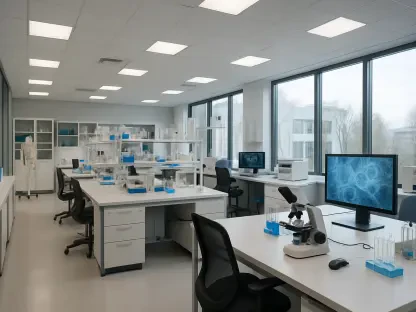Welcoming James Maitland, a leading expert in robotics and IoT applications in medicine, offers us a unique perspective on the medtech IPO landscape. With a keen understanding of how technology drives advancements in healthcare solutions, James will help us explore the factors shaping IPO activities in the medical device industry and potential future trends.
Can you describe the current state of the medtech IPO market? Is the IPO window truly open now?
The medtech IPO market is experiencing a cautious optimism. While Ceribell’s public offering has sparked activity, the window isn’t fully open yet. There’s a mix of excitement and hesitation as companies weigh their options in a market that has been unpredictable. Many are watching these initial steps closely, trying to decipher the true state of the IPO window.
What factors do you believe led to the IPO decline in the medtech industry after the COVID-19 pandemic?
Several factors contributed to this decline. Firstly, post-pandemic economic uncertainties, including inflation and changing interest rates, have made companies more cautious. Additionally, the initial wave of investment enthusiasm that spiked during the pandemic has waned, with many companies perhaps reconsidering or restructuring their goals and strategies in light of a more complex economic environment.
Could you elaborate on how the market dynamics, such as zero interest rates and inflation, affected IPO activity in 2021 compared to post-pandemic years?
In 2021, zero interest rates created a favorable environment for IPOs as investors looked for opportunities with higher returns. This climate led to a spike in IPO activity. However, as inflation concerns grew and rates began to shift, the landscape became more risky, causing companies and investors to reconsider their positions and strategies, leading to fewer IPOs in the following years.
How significant was the IPO activity spike in 2021, and what made it different from previous years?
The spike in IPO activity in 2021 was remarkable because it represented a convergence of unique factors: low interest rates, pent-up investment demand post-COVID, and a strong push towards innovation in healthcare. It was a year where market conditions aligned nicely for companies wanting to go public, differing from previous years where such factors weren’t as synchronized.
What role did Ceribell’s IPO play in recent public offering activities in the medtech sector?
Ceribell’s IPO acted as a catalyst in breaking the prolonged drought in medtech IPOs. By successfully navigating the public offering process, Ceribell demonstrated that despite economic volatility, there was potential in stepping into the public arena. Their IPO has encouraged other medtech firms to consider following suit, reigniting interest in the sector.
Have recent IPOs in the medtech industry signaled an end to the IPO drought?
Recent IPOs have certainly hinted at the end of the drought, but it’s too early to declare it fully over. While the activity is promising, ongoing economic concerns continue to influence decision-making for many companies. It seems we’re seeing the beginning of a recovery phase, but the true test will be sustained momentum over the coming months.
What makes a medtech company a suitable candidate for an IPO in the current market?
Suitable candidates tend to have robust financial health, clear visibility into future revenue streams, and strong leadership teams. Technological innovation that addresses urgent healthcare needs can also make a company appealing. These factors combined help mitigate risks associated with going public, especially in a volatile economy.
How does a volatile economy impact a company’s decision to pursue an IPO?
A volatile economy introduces uncertainty, impacting both valuation and investor confidence. Companies may delay IPOs to wait for more stable conditions or rethink their capital strategies altogether. In such a climate, timing becomes crucial, and many companies grapple with whether entering the public market is worth the risk.
In John Babitt’s opinion, how likely is it for the IPO window to be fully open in the second half of 2025?
John Babitt expressed optimism regarding the potential for a fully open IPO window by the second half of 2025. He notes that if economic conditions improve and stabilize, there could be robust IPO activity. His view hinges on the assumption that the market volatility seen recently will ease as macroeconomic indicators become more favorable.
How does recent volatility and macroeconomic conditions affect newly public companies like Beta Bionics?
Volatility has created challenges for newly public companies, impacting stock performance and investor sentiment. Companies like Beta Bionics often find themselves vulnerable to broader economic shifts that are out of their control, despite having solid financials. Market perception can swing quickly, influencing stock prices in ways that aren’t directly tied to company fundamentals.
Why do companies face challenges in controlling stock price movements after going public?
Once public, companies become subject to market dynamics that can be unpredictable. Factors such as investor sentiment, macroeconomic trends, and industry-specific news can all sway stock prices. For companies new to the market, this can be difficult to manage, especially when external factors have a strong influence on movements unrelated to their actual performance.
How does visibility into revenue streams influence a company’s success post-IPO?
Visibility into revenue streams is crucial for post-IPO success because it demonstrates stability and growth potential to investors. Companies that can articulate and deliver on predictable revenue growth are better positioned to gain investor trust and maintain favorable stock valuations. Those lacking visibility often face credibility challenges and market doubts.
Did the economic slowdown and tariff tensions under the Trump administration impact public offerings of certain medtech companies?
Indeed, the economic environment during Trump’s administration, especially concerning tariff tensions, impacted medtech IPO decisions. These conditions introduced additional layers of uncertainty, thereby influencing companies’ timing and strategies around going public. Some deferred IPOs, seeking clarity and stability before proceeding.
How has the medtech industry responded to the unpredictable nature of the current market, particularly regarding IPO plans?
The industry has become more strategic and cautious in its approach. Companies are investing in thorough preparations and contingency planning to mitigate risks. While some choose to move forward, others hold off for clearer waters. There’s a noticeable trend toward flexibility and resilience, with some exploring alternative routes like mergers and acquisitions.
Are there particular companies or technologies in the medtech space that you foresee spearheading future IPO activity?
Innovative technologies, particularly those addressing critical health challenges like diabetes management and heart disease, stand a good chance of leading future IPO efforts. Companies leveraging AI and IoT in impactful ways will likely spearhead these activities. Their potential to transform healthcare delivery makes them attractive to investors looking for groundbreaking advancements.
How does EY guide companies that are considering going public?
EY provides comprehensive support that includes strategic planning, financial structuring, and navigating regulatory requirements. They focus on ensuring that companies have strong financial health and clear revenue visibility. Their expertise helps companies prepare for the complex process of an IPO, aligning their business objectives with market expectations.
What are some alternative strategies that companies might pursue if the IPO window remains volatile?
If volatility persists, companies might consider mergers and acquisitions as viable paths to growth and funding. Partnerships with larger firms can also provide capital and acceleration without the immediate pressures of public scrutiny. Additionally, private funding rounds and strategic alliances are other ways to achieve financial goals while awaiting better public market conditions.









